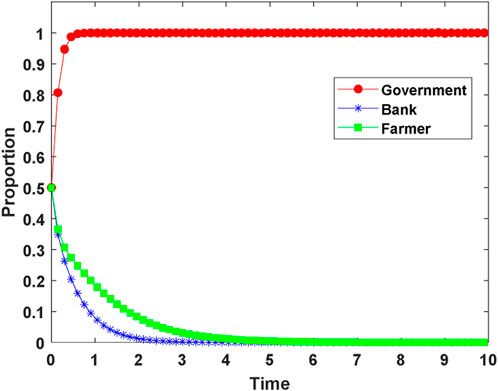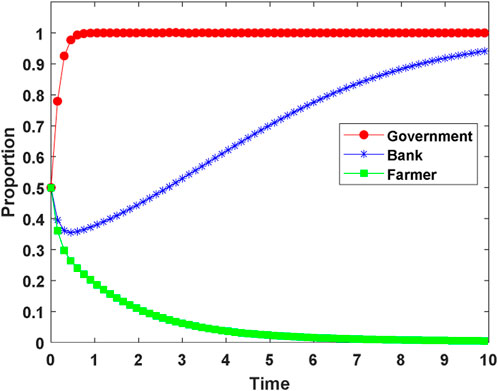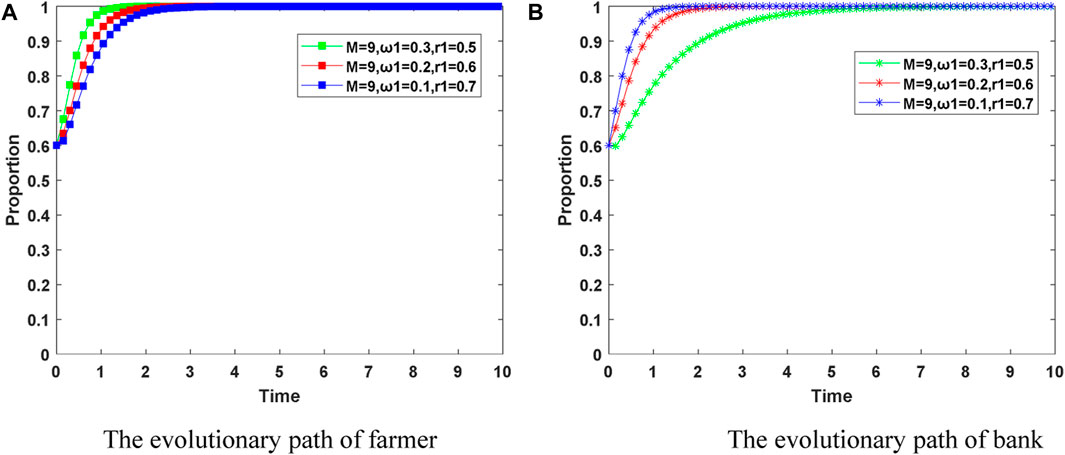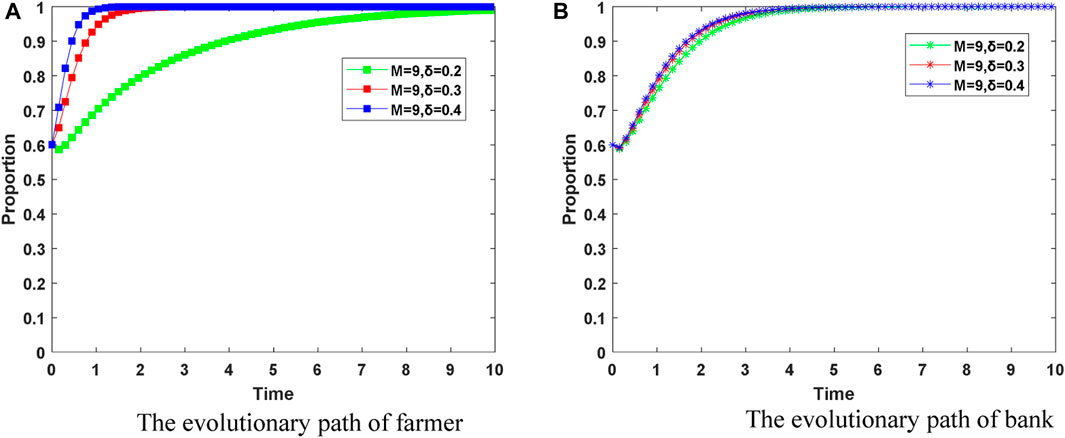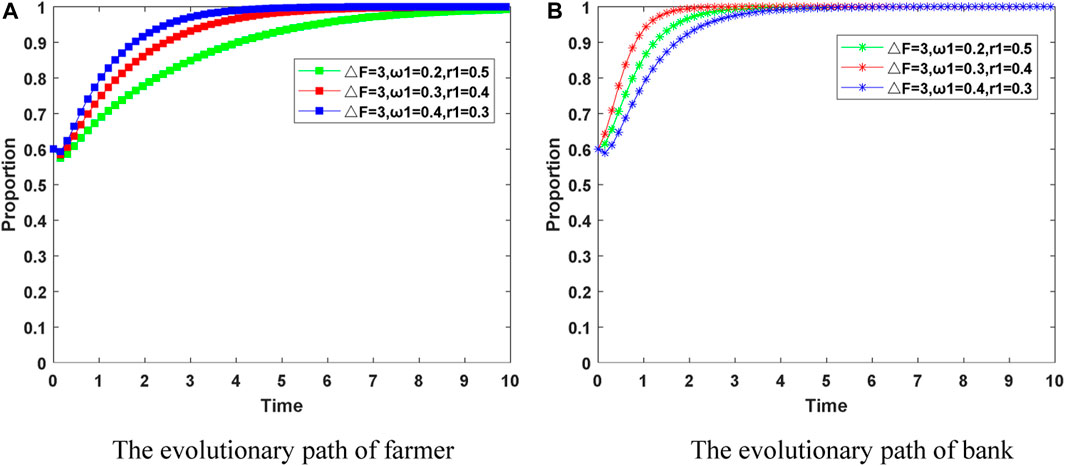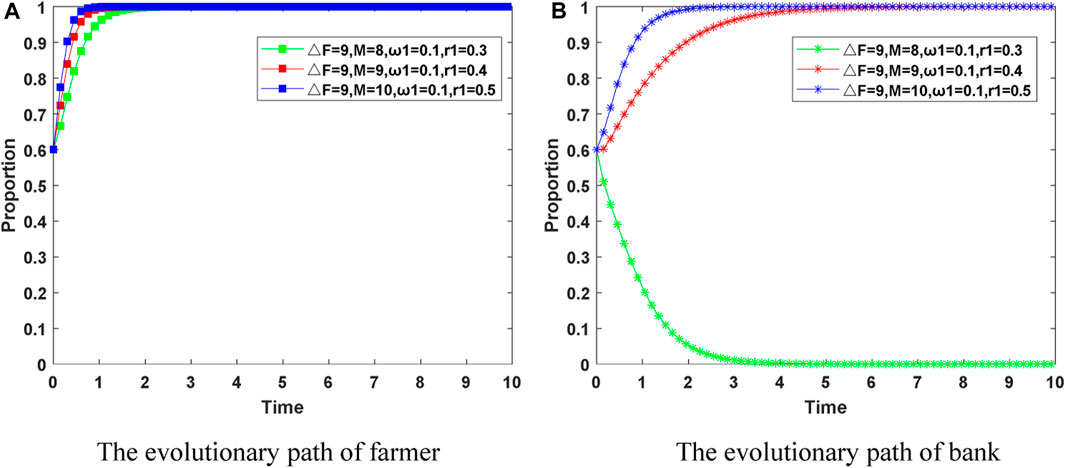- School of Business, Huang Gang Normal University, Huang Gang, Hubei, China
The adoption of agricultural green production technologies (AGPTs) is crucial for achieving agricultural green development in developing countries. This paper establishes a tripartite game model to explore the evolutionary influence mechanism of government environmental regulation policies and bank green credit policies on farmers’ adoption of AGPT under different initial conditions and strategy choices. Through theoretical analysis and numerical simulation, we systematically deduce the evolutionary path and equilibrium conditions, as well as examine the synergistic evolutionary effect of these policies. The results demonstrate that government environmental regulation and banks’ implementation of the green credit policies effectively encourage farmers to adopt AGPT. However, conflicts may arise during the dynamic evolution process when banks choose to implement the green credit policy. These conflicts can be mitigated by utilizing market-oriented mechanisms such as loan interest rates, improving bank supervision efficiency, and enhancing farmers’ expected income. The findings of this research provide valuable insights into the development of external incentive mechanisms to promote the adoption of AGPT among farmers and foster green agricultural development.
Introduction
Effectively guiding and motivating farmers to adopt agricultural green production technologies (AGPT) is crucial to achieve green agricultural development (Li et al., 2020; Li et al., 2021; Liu and Liu, 2022; Guo and Zhang, 2023), especially in developing countries (Tey and Brindal, 2012; Midingoyi et al., 2018). The adoption of AGPT can introduce new production factors into the production process, which is of significant help in improving agricultural productivity, reducing input and increasing output, and controlling pollutant emissions (Abdulai and Huffman, 2014; Liu and Wu, 2020; Khan et al., 2021). In recent years, the Chinese government has issued several policy documents to promote farmers to adopt AGPT, including initiatives to enhance and preserve cultivated land quality, reduce the use of fertilizers and pesticides to improve efficiency, control agricultural non-point source pollution, and promote the recycling of agricultural waste (Adnan et al., 2017; He et al., 2021). According to data released by the Chinese government, the utilization rates of pesticides and fertilizers for rice, wheat, and corn in China reached 40.6% and 40.2% in 2020, only increasing by 5% and 4%, respectively, compared to that in 2015. There remains a significant gap between China and agriculturally advanced countries.
However, at present, under the restriction of many factors, the adoption rate of AGPT among farmers is relatively low (He et al., 2021). Motivating farmers to adopt AGPT urgently requires effective support from external policies. On one hand, compared with traditional agricultural production, the threshold of green production is relatively high, the initial investment for farmers to adopt AGPT is tremendous, and the return cycle is long (Zhang et al., 2021). In addition, agricultural green production has a great uncertainty, the lack of credit support resulting in farmers having insufficient internal motivation to adopt AGPT(Yu et al., 2020; Wei et al., 2020). On the other hand, the adoption of AGPT is helpful for energy saving and emission reduction, which demonstrates a strong positive externality (Li and Bai, 2019). However, the ecological benefits of farmers adopting AGPT are much higher than the economic benefits, thereby reducing the enthusiasm of individual farmers (Wei et al., 2020). The government external intervention plays a crucial role in motivating farmers to adopt AGPT and enhancing overall social welfare (Nakano and Magezi, 2020). Therefore, it is necessary to explore how different policies can promote farmers’ adoption of AGPT under the external intervention of the government.
In practice, environmental regulation and green credit are important policy instruments for the government to motivate farmers to adopt AGPT in China (Guo et al., 2022; Luo et al., 2022; Zheng and Su, 2023). However, there exists a debate within academia regarding whether environmental regulation can effectively motivate farmers to adopt AGPT and enhance economic performances (Hou et al., 2019). On one hand, the government guides farmers to adopt AGPT through the establishment of environmental standards and the development of relevant policies and regulations (Pratt and Wingenbach, 2016; Lu et al., 2022; Wang et al., 2023). Nevertheless, the “compliance costs” associated with governmental environmental regulation can increase the expenses of procuring green raw materials and new equipment, which may diminish farmers’ willingness to adopt AGPT (Li et al., 2021b). On the other hand, the government also offers various incentive measures, such as tax reductions and subsidies, to amplify the “compliance benefits” for farmers and encourage them to adopt AGPT (Isik, 2004; Guo et al., 2021; Zhang et al., 2021). Under the government’s external intervention, the threshold condition for farmers to adopt AGPT is that the “compliance benefits” surpass the “compliance cost,” which is also a crucial criterion for assessing the reasonability of environmental regulations (Tang et al., 2021). In existing empirical research, Ma (2023) discovered that environmental regulations reduce household income, as with reduction in incomes, people will focus more on economic development than on environmental issues. Yu et al. (2019), based on the sample data of 818 tea farmers in China’s geographical indication protection areas, discovered that punitive environmental regulations have no significant effect on tea farmers’ reducing pesticide behavior, while incentive environmental regulations such as technology subsidies and product subsidies have a significant effect. Shi and Zhang (2021) shows that diverse types of environmental regulation combinations can better encourage farmers to adopt AGPT.
On the financing side, bank credit is an important channel for farmers to obtain financial support (Li and Bai, 2019; Wang et al., 2023; Zheng and Su, 2023). The green credit policy is based on credit rationing rules that combine “environmental protection” and “financial integration” (Bian et al., 2022). By setting a certain “environmental threshold,” it releases signals orienting toward encouraging farmers’ green production, thereby alleviating the burden on farmers in paying off the currency interest and reducing production cost (Yang et al., 2019; Zheng and Su, 2023). However, as a profitable market entity, banks decide whether to provide green credit support based on fully evaluating the risk of farmers adopting AGPT by using Big Data, cloud computing, artificial intelligence, blockchain, and other technologies (Yu et al., 2020; Li et al, 2021). Driven by the goal of “maximizing profits,” banks are prone to opportunistic behavior, which may increase credit support for “non-environmentally friendly” projects (Mao et al., 2022; Li et al., 2022). In addition, the greenwashing behavior of some farmers may cause banks to suffer from losses due to “fraudulent loans.” To reduce the risk of “fraudulent loans,” banks will respond to government environmental supervision strategies by not implementing the green credit policy (Hu et al., 2017; Sun et al., 2021). Therefore, it will be difficult to motivate farmers to adopt AGPT if banks implement the green credit policy without effective government regulatory constraints.
To sum up, under the external intervention of the government, whether banks implement the green credit policy and whether farmers adopt AGPT are based on the cost–benefit comparison (Lin et al., 2021; Yang and Qi, 2022). The strategy selection based on cost–benefit analysis is not only affected by the influence of external government intervention but also influenced by the dynamic evolution process of imitation, learning, and variation from different groups (Tian et al., 2022; Sun and Gu, 2022; Luo et al., 2023). It is a collaborative game process involving local governments, banks, and farmers. Currently, some scholars have used the evolutionary game model to study decision-making problems among the government, banks, and farmers from the perspective of environmental regulation or green credit. Wang et al. (2022) constructed a game model and analyzed the changing rules of strategy choice between borrowers and lenders. Tang et al. (2021) and Deng et al. (2021), based on the perspective of supply chain finance, constructed an evolutionary game model involving the three parties of family farm, e-commerce platform, and rural credit cooperatives. Liu and Wu (2022) also constructed an evolutionary game model of green transformation of farmers’ production led by cooperatives under the environmental regulations and explored the impact of differences in the initial willingness of various subjects on the evolution of green transformation of farmers’ production.
Through the literature reviewed, it can be found that previous research has mainly focused on the strategic interaction among the government, banks, and farmers within the context of environmental regulation or green credit. However, few scholars have examined these three entities together within a single framework. Additionally, there is a lack of research concerning how to regulate bank execution of green credit policies and facilitate the adoption of AGPT by farmers from the perspective of government environmental regulation policy design. Based on the research purpose and existing literature, this paper aims to address the following key issues: 1) what are the factors that promote farmers to adopt AGPT under different environmental regulation policies? 2) Can government environmental regulation policies and bank green credit policies synergistically promote the evolution of farmers in adopting AGPT? Is there a policy conflict and how to avoid it? 3) What is the evolutionary path of farmers’ adoption of AGPT through the implementation of government environmental regulation policies and bank green credit policies? And what are the realistic conditions need to be met? In response to the aforementioned problems, this paper constructs a tripartite cooperative evolutionary game model among the government, banks, and farmers, exploring the evolution paths, equilibrium state, and collaborative conditions of environmental regulation policies and green credit policies, which synergistically promote farmers to adopt AGPT so as to develop an external incentive mechanism that promotes farmers to adopt AGPT and facilitate green agricultural development.
The rest of the study is organized as follows. The second part presents and analyzes a tripartite evolutionary game model. The third part solves the model and analyzes the stability of various strategies. Next, simulation analysis and parameter sensitivity are discussed. Finally, the conclusions and suggestions are presented.
Model hypothesis and model construction
In the process of agricultural green development, the government plays a crucial role as the creator and supervisor of environmental regulations and green credit policies. To support and accelerate the green development of agriculture, the government needs to formulate appropriate financial support policies, in addition to providing technical subsidies to farmers. Furthermore, in order to guide farmers toward adopting AGPT, the government should enforce regulations on market participants, such as banks and farmers, ensuring the effective implementation of relevant policies. Banks serve as the implementers of green credit policies, and they implement different credit rates to encourage farmers to adopt AGPT. Additionally, digital technology is utilized by banks to assess farmers’ eligibility for loans and to mitigate credit risks. This technological assessment also guarantees the proper utilization of green credit funds. At the same time, farmers are vital participants in the adoption of AGPT, including ordinary farmers, specialized households, family farms, and other new types of agricultural businesses. They must make decisions on whether to adopt AGPT and apply for green credit by weighing factors such as investment cost, technical feasibility, and market risks. It is important to recognize that the decision-making process of farmers regarding the adoption of AGPT may not always be entirely rational. Based on the aforementioned points, the following hypotheses are proposed:
Assumption 1. Due to information asymmetry, in the process of agricultural green development, the government will have two choice strategies: “strict supervision” and “loose supervision,” that is, the strategic space of the government is (strict supervision and loose supervision), and the probability of choosing “strict supervision” is
Assumption 2. The government incentivizes farmers to adopt AGPT through both “technology subsidy” and “pollution penalty” policies. The “technology subsidy” has a positive incentive effect, whereas “pollution penalty” has a negative incentive effect. Additionally, the government has implemented a green credit policy to motivate farmers to adopt AGPT. Banks also provide preferential loan rates
Assumption 3. The adoption of AGPT by farmers will result in increased costs, such as the purchase of green raw materials, related equipment, and the acquisition of new production technologies.
Assumption 4. The government assesses the situation of farmers adopting AGPT and banks implementing green credit policies through supervision. When the government chooses the “strict implementation” strategy: if the farmers choose the strategy of adoption, they will receive technical subsidies from the government, where
Based on the aforementioned assumption, the income payment matrix of the government, banks, and farmers is presented in Table 1.
In the strategy profile of (G1,B1,F1), the government’s payoff for choosing the strategy of “strict supervision” is the sum of the comprehensive benefits from the improvement of environmental quality and the reputation enhancement of local governments
According to the aforementioned payoff matrix, we can calculate the replication dynamic equations for different strategy choices of the government, banks, and farmers.
The expected benefits of the government choosing the strategy of “strict supervision” are represented by
The replication dynamic equation of the government is as follows:
The expected benefits of banks choosing the strategy of “implementation” are represented by
The replication dynamic equation of banks is as follows:
The expected benefits of farmers choosing the strategy of adopting AGPT are represented by
The replication dynamic equation of farmers is as follows:
Combining three equations, the replication dynamic system of the government, banks, and farmers is as follows:
Equilibrium point and stability analysis of the evolutionary game
According to the research conclusion of Reinhard, we can judge the strategy portfolio stability by analyzing the Jacobian matrix. The Jacobian matrix of the evolutionary system is as follows:
Among them,
In the dynamic system composed of three game agents, assuming
To analyze the evolutionary path of environmental regulation and green credit policies promoting the adoption of AGPT by farmers, the following two situations are discussed:
(1) When
Based on the aforementioned analysis, first, we can see that the combination of environmental regulation policies and green credit policies is a necessary condition to promote farmers to adopt AGPT. When the policy benefits of local governments through strict supervision outweigh their expenditures, and the long-term benefits of banks implementing green credit policies surpass their costs, farmers have the incentive to adopt AGPT when the technical subsidy exceeds the critical value
(2) When
Through the aforementioned analysis, first, we can see that the strategic choice of banks to implement green credit policies is profit-driven, which is consistent with the current situation in China where the implementation effects of green credit are unsatisfactory. At present, due to the long-term benefits of implementing green credit and adopting AGPT being unclear to banks and farmers, the adoption rates of green credit and AGPT remain low. Even if the government adopts reward and punishment regulation measures, banks and farmers will eventually choose “non-implementation” and “non-adoption” strategies. To overcome this poverty trap, the government should strengthen the regulation by increasing the technology subsidy coefficient
Evolutionary simulation and analysis
To assess the validity of the research conclusions, this paper utilizes the MATLAB 2020b system simulation tool to simulate the dynamic evolution path of the game participants. Initially, the model parameters are assigned based on statistical data and public information. The impact and effectiveness of various policy tools on the system’s convergence toward an ideal evolutionary stable equilibrium E5 (1,1,1) are then simulated.
The basis of assignment parameters and data source
The basis of the assignment of main parameters is based on the China Environmental and Economic Policy Progress Evaluation Report of 2022. The value of “government environmental pollution control cost”
The study collected the data from the “China Rural Research Database.” This database is a reliable and comprehensive resource that consolidates the research findings of large-scale projects focusing on Chinese villages. It provided various resources concerning the development of rural revitalization in China, including think tank reports and investigation materials such as reports, data, and interview materials. Based on the data provided by the database, we calculated the ratio of
The assignment of other parameters is based on the relationship between different parameters. Considering the principle that “compliance benefits” should exceed “compliance cost,” the total amount of green credit applied by farmers is not less than the increased cost of adopting AGPT, Therefore, let
Analysis of model simulation results
Convergence of the benchmark scenario system
Based on the aforementioned parameter’s assignment,
According to Table 4, E6 (1,0,0) is the evolutionary stable point. The strategy choices of different subjects are as follows: farmers not adopting AGPT, banks not implementing green credit policies, and the government choosing a strict supervision strategy. This state represents the worst system convergence with regard to evolutionary stability. In this scenario, government intervention not only fails to produce the desired outcome but also incurs the cost of strict supervision. Judging from the conditions for the gradual stability of E6 (1,0,0),
Banks’ green credit strategy simulation
Based on the simulation results of the benchmark situation, to realize the policy goal of environmental regulation and green credit synergistically promoting farmers to adopt AGPT, the government must change the banks’ strategic choice of “non-implementation.” One solution is for the government to increase subsidy support for banks. When
It can be seen from Figure 2 that the evolutionary system eventually converges to the evolutionary stable point E7 (1,1,0) after 10 periods. The strategy choices of different subjects are as follows: farmers not adopting AGPT, banks implementing green credit policies, and the government choosing the strict supervision strategy. By comparing it to E6 (1,0,0), it is evident that increasing subsidy standards can reduce that risk associated with banks implementing green credit policies. Banks will change their strategy choice of “non-implementation” because the government subsidies’ bottom-line guarantee can stabilize the losses caused by “fraudulent loans.” However, even with government intervention, the policy goal of farmers adopting AGPT still has not been achieved since the net income for farmers who choose the “adoption” strategy is negative. It indicates that a combination of environmental regulation policies and green credit policies is essential to promote the adoption of AGPT among farmers. Therefore, the realization of the farmers’ policy goal depends on the combination of various policy tools.
Simulation of government environmental regulation intensity
Farmers adopting AGPT must meet the condition of
As shown in Figure 3A, when the proportion of farmers adopting AGPT is low
By comparing Figures 4A, B, it is evident that by keeping the intensity of government environmental regulation unchanged
Simulation of banking supervision efficiency
In order to prevent farmers from resorting to fraudulent loans, banks need to strengthen their supervision of green credit. Neglecting such supervision will lead to fraudulent loans, which not only inhibits the incentive effect of green credit in promoting farmers’ adoption of AGPT but also affects the synergistic effect of the green credit and environmental regulation policies. In the model setting, the probability of discovering farmers’ fraudulent loans affects the income of both farmers and banks, and increasing this probability indicates an improvement in bank supervision efficiency, thereby reducing the profits of farmers’ production during the period of fraudulent loans. Keeping other parameters unchanged, we simulate the impact of the combination of environmental regulation and green credit policy on the system convergence to E5 (1,1,1). The simulation results are shown in Figure 5.
By comparing Figures 5A,B, it can be observed that the evolution rate of banks implementing green credit strategies does not vary significantly with the increase of
Simulation of expected income of farmers adopting AGPT
Expected income plays a pivotal role in driving farmers to adopt AGPT. Different expected income has an impact on the implementation effectiveness of green credit and environmental regulation in promoting AGPT adoption by farmers. In the model setting,
It can be observed from Figures 6A, B that when the expected income of farmers adopting AGPT is low (
It can be seen in Figures 7A, B that when the expected income of farmers adopting AGPT is high ((
Conclusion and recommendations
This study establishes a non-cooperative evolutionary game model to analyze the relationship between government environmental regulation, bank green credit support, and farmers’ adoption of AGPT and explores the optimal conditions for achieving evolutionary stability and equilibrium in promoting farmers’ adoption of AGPT through environmental regulation and green credit policy. Additionally, numerical simulations are used to assess the synergistic effect of implementing environmental regulation and green credit policies.
The research findings indicate several key points: first, different from the previous research focused on the impact of a single environmental regulation policy on farmers’ environmental behavior (Lu et al., 2022; Liu and Liu, 2022), the combined mechanism design and regulatory intervention of environmental regulation and green credit policies effectively incentivize farmers to adopt AGPT. Second, in order to achieve the policy goal of promoting farmers’ adoption of AGPT through the synergistic implementation of environmental regulation and credit policies, the government must change the strategic choices of banks by reducing the risks associated with implementing green credit policies and providing government subsidies. Third, conflicts may arise during the dynamic evolution of environmental regulation and green credit policies in promoting farmers’ adopting of AGPT, which differs from previous conclusions drawn in the game between the government, banks, and farmers (Tang et al., 2021; Deng et al., 2021). To mitigate these conflicts, the government should adopt a flexible combination strategy for environmental regulation, while simultaneously enhancing bank supervision efficiency and improving farmers’ expected income. By implementing these measures, the policy conflict losses between green credit and environmental regulation can be effectively reduced, and the policy regulation goals can be achieved.
To promote the adoption of AGPT among farmers, based on the research conclusions, this paper proposes the following policy recommendations: 1) enhance the external policy incentive mechanism to guide farmers to produce green transformation. In cases where the number of farmers adopting AGPT is low, the government should implement a combination of “high subsidy + low penalty,” while banks should adopt the strategy combination of “low interest rate + high supervision.” This will help alleviate cost pressures faced by farmers when adopting AGPT and reduce the policy risks associated with green credits. As the proportion of farmers adopting AGPT increases, the government can shift to a strategy of “low subsidy + high penalty,” while banks can fully utilize the role of marketizing interest rates to minimize conflicts in policy coordination and guide farmers to adopt AGPT. 2) Foster continual innovation in financial services, while expanding the scale and scope of green credit support for agriculture. On the supply side, the government should further improve the financial service system, supporting financial institutions in developing various carbon financial products suitable for agriculture, rural areas, and farmers. This will create new opportunities for issuing green agricultural credits. On the demand side, banks should broaden the financial service coverage channels through seamless “online + offline” connection, improve the availability of green credits for farmers, and drive the green transformation of farmers’ production. 3) Maximize the technical advantages of digital finance to enhance the efficiency of bank green credit supervision. On one hand, developing digital online lending technology and simplifying the approval process of farmers’ green credit application can help reduce the supervision costs associated with banks’ green credit. On the other hand, reducing the degree of information asymmetry between banks and farmers and reduce the environmental and social risks of banks’ green credit. 4) Intensify promotion of AGPT, strengthen farmers’ income expectations for AGPT adoption, and improve farmers’ enthusiasm and initiative in adopting AGPT.
This paper analyzes the government, banks, and farmers within the same framework, which overcomes the limitations of previous studies that only focus on pairwise games. However, there are still some factors that have not been taken into consideration, such as the lack of consideration for the consumer’s strategic choices. In fact, consumers play a vital role in the process of agricultural green transformation and development, and their preferences for green agricultural products significantly influence farmers’ adoption of AGPT and banks’ implementation of green credit. Therefore, it is important to introduce consumers and analyze the evolutionary game of the four parties. In addition, some novel ideas proposed in this study require empirical testing. The author will also further explore through empirical research.
Data availability statement
The raw data supporting the conclusion of this article will be made available by the authors, without undue reservation.
Author contributions
ZZ: writing–original draft and writing–review and editing.
Funding
The author(s) declare financial support was received for the research, authorship, and/or publication of this article. This study received the following grants: Philosophy and Social Science Research Major project of Hubei Provincial Universities (pre-funded project of the Provincial Social Science Fund): “Research on synergistic mechanism and realization path of high-quality development of the whole pig industry in Hubei Province” (Grant Number: 21ZD129); High-Level Cultivation Key Project of Huanggang Normal University: “Research on long-term mechanism and path optimization of collaborative governance of rural environment under the background of overall rural revitalization” (Grant Number: 202109104); The Key project of Dabi Mountain Country Zhen Xing Research Institute: “Research on the mechanism and path of industrial integration promoting rural industrial revitalization in Dabi mountain revolutionary old area” (Grant Number: 202218004) and College Students’ Innovative Entrepreneurial Training Project: “Study on the mechanism and path of “red-green integration” to promote the all-round revitalization of rural areas in the old revolutionary areas: taking Dabi mountain as an example” (Grant Number: 202210514015).
Conflict of interest
The authors declare that the research was conducted in the absence of any commercial or financial relationships that could be construed as a potential conflict of interest.
Publisher’s note
All claims expressed in this article are solely those of the authors and do not necessarily represent those of their affiliated organizations, or those of the publisher, the editors, and the reviewers. Any product that may be evaluated in this article, or claim that may be made by its manufacturer, is not guaranteed or endorsed by the publisher.
References
Abdulai, A., and Huffman, W. (2014). The adoption and impact of soil and water conservation technology: An endogenous switching regression application. Land Econ. 90 (1), 26–43. doi:10.3368/le.90.1.26
Adnan, N., Norden, S., and Noor, A. (2017). Adoption of green fertilizer technology among paddy farmers: A possible solution for malaysian food security. Land Use Pol. 63, 38–52. doi:10.1016/j.landusepol.2017.01.022
Bain, C., Chu, Z., and Sun, Z. (2022). Policy simulation modeling environmental regulation and green credit in enterprise green innovation in technology: An evolutionary game analysis of government intervention. Manag. Rev. 34 (10), 122–133. doi:10.14120/j.cnki.cn11-5057/f.2022.10.009
Deng, L., Xu, W., and Luo, J. (2021). Optimal loan pricing for agricultural supply chains from a green credit perspective. Sustainability 13 (22), 12365. doi:10.3390/SU132212365
Guo, L., Li, H., Cao, X., Cao, A., and Huang, M. (2021). Effect of agricultural subsidies on the use of chemical fertilizer. J. Environ. Manag. 299, 113621. doi:10.1016/j.jenvman.2021.113621
Guo, Z., Chen, X., and Zhang, Y. (2022). Impact of environmental regulation perception on farmers’ agricultural green production technology adoption: A new perspective of social capital. Technol. Soc. 71, 102085. doi:10.1016/j.techsoc.2022.102085
Guo, Z., and Zhang, X. (2023). Carbon reduction effect of agricultural green production technology: A new evidence from China. Sci. Total Environ. 874, 162483. doi:10.1016/j.scitotenv.2023.162483
Hao, C., Dong, Z., Cheng, C., et al. (2023). National environmental economic policy progress 2022. Chin. J. Environ. Manag. 15 (02), 58–65. doi:10.16868/j.cnki.1674-6252.2023.02.058
He, P., Zhang, J., and Li, W. (2021). The role of agricultural green production technologies in improving low-carbon efficiency in China: Necessary but not effective. J. Environ. Manag. 293, 112837. doi:10.1016/j.jenvman.2021.112837
Hou, X., Liu, T., Huang, T., et al. (2019). Adoption behavior and income effects of green agricultural technology for farmers. J. NWAF.Univ. Soc. Sci. Ed. 19 (3), 121–131. doi:10.13968/j.cnki.1009-9107.2019.03.15
Hu, Z., Zhang, Q., and Donaldson, J. A. (2017). Farmers’ cooperatives in China: A typology of fraud and failure. China J. 78 (1), 1–24. doi:10.1086/691786
Isik, M. (2004). Incentives for technology adoption under environmental policy uncertainty: Implications for green payment programs. Environ. Resour. Econ. 27, 247–263. doi:10.1023/B:EARE.0000017624.07757.3f
Khan, F. Z. A., Manzoor, S. A., Akmal, M. U., Imran, M. U., Taqi, M., et al. (2021). Modeling pesticide use intention in Pakistani farmers using expanded versions of the theory of planned behavior. Hum. Ecol. Risk Assess. 27 (3), 687–707. doi:10.1080/10807039.2020.1750345
Li, H., Liu, Y., Zhao, X., Zhang, L., and Yuan, K. (2021a). Estimating effects of cooperative membership on farmers’ safe production behaviors: Evidence from the rice sector in China. Environ. Sci. Pollut. Res. 28, 25400–25418. doi:10.1007/s11356-020-12337-z
Li, J., Lu, Q., Xue, Z., Yang, B., Wang, M., Li, S., et al. (2022). Reconfigurable radar signal generator based on phase-quantized photonic digital-to-analog conversion. Resour. Sci. 44 (12), 2470–2473. doi:10.1364/OL.458132
Li, L., Jing, L., and Bo, X. (2021b). What factors determine farmers’ willingness to adopt green production technology: Market or government? Econ. Issues 508 (12), 67–74. doi:10.16011/j.cnki.jjwt.2021.12.011
Li, M., and Bai, H. (2019). Credit support for the green development of agriculture. Res. Agric. Mod. 40 (6), 900–906. doi:10.13872/j.1000-0275.2019.0070
Li, M., Wang, J., Zhao, P., Chen, K., and Wu, L. (2020). Factors affecting the willingness of agricultural green production from the perspective of farmers’ perceptions. Sci. Total Environ. 738, 140289. doi:10.1016/j.scitotenv.2020.140289
Li, Z., Zhu, M., Zuo, Q., Peng, Q., Wu, Y., Wen, Y., et al. (2022). Macrophage-biomimetic nanoparticles ameliorate ulcerative colitis through reducing inflammatory factors expression. Front. Environ. Sci. 10, 380–392. doi:10.1159/000519363
Liu, T., and Wu, G. (2022). Does agricultural cooperative membership help reduce the overuse of chemical fertilizers and pesticides? Evidence from rural China. Environ. Sci. Pollut. Res. 29 (5), 7972–7983. doi:10.1007/s11356-021-16277-0
Liu, W., and Liu, Z. (2022). Retraction Note: Long non-coding RNA VPS9D1-AS1 promotes growth of colon adenocarcinoma by sponging miR-1301-3p and CLDN1. Front. Environ. Sci. 10, 2030. doi:10.1007/s13577-022-00784-4
Lu, Y., Tan, Y., and Wang, H. (2022). Impact of environmental regulation on green technology adoption by farmers microscopic investigation evidence from pig breeding in China. Front. Environ. Sci. 10, 885933. doi:10.3389/fenvs.2022.885933
Luo, J., Hu, M., Huang, M., and Bai, Y. (2023). How does innovation consortium promote low-carbon agricultural technology innovation: An evolutionary game analysis. J. Clean. Prod. 384, 135564. doi:10.1016/j.jclepro.2022.135564
Luo, L., Yang, X., Niu, W., et al. (2022). Cognitive norms, institutional environment and multi-stage dynamic adoption process of fruit farmers adopting green production technology: An analysis based on triple-hurdle model. J. Agrotechn. Econ. 330 (10), 98–113. doi:10.13246/j.cnki.jae.20211228.001
Ma, X. (2023). Environmental regulation and public environmental concerns in China: A new insight from the difference in difference approach. Green Low-Carbon Econ. doi:10.47852/bonviewGLCE3202868
Mao, H., Hu, R., Zhou, L., and Sun, J. (2022). Crop insurance and farmers’ adoption behavior of green agricultural technology: Analysis based on cotton farmers. J. Agrotechn. Econ. 331 (11), 95–111. doi:10.13246/j.cnki.jae.2022.11.004
Midingoyi, S. K. G., Kassie, M., Muriithi, B., Diiro, G., and Ekesi, S. (2018). Do farmers and the environment benefit from adopting integrated pest management practices? Evidence from Kenya. J. Agric. Econ. 70 (2), 452–470. doi:10.1111/1477-9552.12306
Nakano, Y., and Magezi, E. F. (2020). The impact of microcredit on agricultural technology adoption and productivity: Evidence from randomized control trial in Tanzania. World Dev. 133, 104997. doi:10.1016/j.worlddev.2020.104997
Pratt, O., and Wingenbach, G. (2016). Factors affecting adoption of green manure and cover crop technologies among paraguayan smallholder farmers. Agroecol. Sustain. Food Syst. 40 (10), 1043–1057. doi:10.1080/21683565.2016.1230568
Shi, Z., and Zhang, H. (2021). Research on social Norms, environmental regulations and farmer’ fertilization behaviors selection. Chin. J. Agric. Resour. Reg. Plan. 42 (11), 51–61. doi:10.7621/cjarrp.1005-9121.20211107
Sun, R., He, D., and Su, H. (2021). Evolutionary game analysis of blockchain technology preventing supply chain financial risks. J. Theor. Appl. Electron. Commer. Res. 16 (7), 2824–2842. doi:10.3390/jtaer16070155
Sun, Y., and Gu, Z. (2022). Implementation of construction waste recycling under construction sustainability incentives: A multi-agent stochastic evolutionary game approach. Sustainability 14 (6), 3702. doi:10.3390/su14063702
Tang, T., Luo, X., and Zhang, J. (2021). Environmental policies and farmers’ environmental behaviors: administrative restriction or economic incentive. Chin. Popul. Resour. Environ. 31 (6), 147–157. doi:10.12062/cpre.20200939
Tey, Y. S., and Brindal, M. (2012). Factors influencing the adoption of precision agricultural technologies: A review for policy implications. Precis. Agric. 13, 713–730. doi:10.1007/s11119-012-9273-6
Tian, M., Zheng, Y., Sun, X., and Zheng, H. (2022). A research on promoting chemical fertiliser reduction for sustainable agriculture purposes: Evolutionary game analyses involving ‘government, farmers, and consumers’. Ecol. Indic. 144, 109433. doi:10.1016/j.ecolind.2022.109433
Wang, L., Hu, Y., and Kong, R. (2023). The impact of bancassurance interaction on the adoption behavior of green production technology in family farms: Evidence from China. Land 12 (5), 941. doi:10.3390/land.12050941
Wang, X., Ma, Y., Li, H., and Xue, C. (2022). How does risk management improve farmers’ green production level? Organic fertilizer as an example. Front. Environ. Sci. 10, 946855. doi:10.3389/fenvs.2022.946855
Wei, H., Xia, Y., and Li, Y. (2020). Analysis of farmers’ environmental-friendly technology adoption behavior: An empirical study from the perspective of credit demand restraint. J. Huazhong Agric. Univ. Soc. Sci. Ed. 145 (1), 56–66+164. doi:10.13300/j.cnki.hnwkxb.2020.01.007
Yang, D. X., Chen, Z. Y., Yang, Y. C., and Nie, P. y. (2019). Green financial policies and capital flows. Phys. A 522, 135–146. doi:10.1016/j.physa.2019.01.126
Yang, X., and Qi, Z. (2022). The impact of expected return and technical subsidy on farmers’ adoption of agroecological technology: Taking rice-crayfish co-culture technology as an example. J. Huazhong Agric. Univ. Soc. Sci. Ed. 161 (5), 89–100. doi:10.13300/j.cnki.hnwkxb.2022.05.010
Yu, L., Zhao, D., Xue, Z., and Gao, Y. (2020a). Research on the use of digital finance and the adoption of green control techniques by family farms in China. Technol. Soc. 62, 101323. doi:10.1016/j.techsoc.2020.101323
Yu, W., Luo, X., Tang, L., Lou, J., Liu, P., Meng, L., et al. (2020b). Farmers’ adoption of green production technology: Policy incentives or value identification? J. Ecol. Rural. Environ. 36 (03), 318–321. doi:10.3760/cma.j.issn.0253-2727.2020.04.011
Yu, Y., Li, H., and Xue, C. (2019). The role of the gut microbiota in lipid and lipoprotein metabolism. Resour. Sci. 41 (12), 2227–2236. doi:10.3390/jcm8122227
Zhang, H., Li, J., and Shi, D. (2021). Research on the influence of environmental regulation and ecological cognition on farmers’ organic fertilizer adoption behavior. Chin. J. Agric. Resour. Reg. Plan. 42 (11), 42–50. doi:10.7621/cjarrp.1005-9121.20211106
Zhang, T., Yan, Y., He, K., et al. (2017). Impact of capital endowment on peasants’ willingness to invest in green production:Taking crop straw returning to the field as an example. Chin. Popul. Resour. Environ. 27 (8), 78–89. doi:10.12062/cpre.20170422
Keywords: environmental regulation, green credit, agricultural green production technology, farmer adoption, evolutionary game
Citation: Zuo ZP (2023) Environmental regulation, green credit, and farmers’ adoption of agricultural green production technology based on the perspective of tripartite evolutionary game. Front. Environ. Sci. 11:1268504. doi: 10.3389/fenvs.2023.1268504
Received: 28 July 2023; Accepted: 18 September 2023;
Published: 09 October 2023.
Edited by:
Xianyou Pan, Shanghai University of Electric Power, ChinaReviewed by:
Henning Otte Hansen, University of Copenhagen, DenmarkDengke Yu, Nanchang University, China
Mahmood Ahmad, Shandong University of Technology, China
Copyright © 2023 Zuo. This is an open-access article distributed under the terms of the Creative Commons Attribution License (CC BY). The use, distribution or reproduction in other forums is permitted, provided the original author(s) and the copyright owner(s) are credited and that the original publication in this journal is cited, in accordance with accepted academic practice. No use, distribution or reproduction is permitted which does not comply with these terms.
*Correspondence: Zhi Ping Zuo, enVvbHVvMDUyM0BzaW5hLmNvbQ==
 Zhi Ping Zuo
Zhi Ping Zuo



